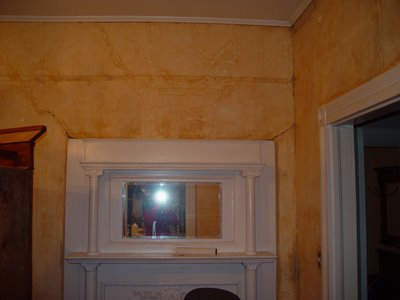I know that the world is waiting to find out how our wallpaper stripping project turned out ... wait no more.
The good news: it turned out better than Mr. Sun's garage cleaning project. (Unfortunately, my graphics are not as good as his.) We even had unsolicited participation by teenagers, who could not resist the impulse to apply sharp instruments to the hated Persian Rose paper.
There was actually a little surprise underneath those 3 recalcitrant, unregenerate, prideful layers of paper, but I didn't notice it until the job was done. Actually, I didn't notice it at all -- Laurette did. If you look carefully, you can see it in this photo.

Notice the ghost of a horizontal stripe around the wall, showing that the room originally had a picture molding. One of the small rewards of renovating old houses (and being married to an archaeologist with a good eye for traces of the past) is discovering nice little bits like that. We're definitely restoring the molding after the plaster gets repaired.
We also learned (pathei mathos: "learning comes from suffering") the three rules of effective wallpaper removal:
(1) Perforate the paper with this. More time perforating means less time scraping. Perforate about 3 times as much as seems necessary, especially if your wallpaper has been painted over or is vinyl. The little holes allow the magic of the next step to work.
(2) Soak the paper with a solution of DIF using this, liberally. Keep soaking. More soaking, less scraping. DIF has an enzyme that eats wallpaper paste. It's almost as much fun as using paint stripper on old woodwork, except it doesn't cause cancer.
(3) When it's time to scrape, don't even think of using anything but something like this to scrape with. Get the kind with replaceable, razor-sharp blades. You may cut yourself, but bleeding a little is preferable to unneeded scraping.
In sum, better wallpaper removal through chemistry and physics.
1 comment:
I read your post from two years ago on "deo vindice" and wanted to add my bit. I read the transcript of the speech in the Confederate Senate urging adoption of this motto, and they seemed to know what they were doing, but may have gotten confused on the grammar.
To wit, by CSA Sen. Thomas Semmes of Louisiana:
"Having discarded the word 'duce,' the committee endeavored to select in lieu of it a word more in consonance with the attributes of the Deity, and therefore more imposing and significant. They think success has crowned their efforts in the selection of the word 'vindex,' which signifies an assenter, a defender, protector, deliverer, liberator, a mediator and a ruler or guardian. 'Vindex' also means an avenger or punisher.
"No word appeared more grand, more expressive or significant than this. Under God as the asserter of our rights, the defender of our liberties, our protector against danger, our mediator, our ruler and guardian, and, as the avenger of our wrongs and the punisher of our crimes, we endeavor to equal or even excel our ancestors. What word can be suggested of more power, and so replete with sentiments and thoughts consonant with our idea of the omnipotence and justice of God?
"At this point the committee hesitated whether it were necessary to add anything further to the motto 'Deo Vindice.' These words alone were sufficient and impressive, and, in the spirit of the lapidary style of composition, were elliptical and left much to the play of the imagination."
I don't know if that makes a lot of difference, but it should provide context.
Post a Comment